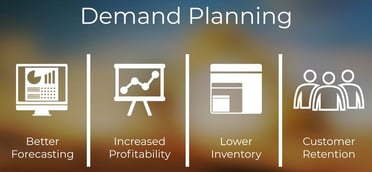Demand planning is a critical cross-functional process, which helps to align and forecast customer demand for a product or business. It aids to optimize inventory management, avoid supply chain disruptions, and minimize supply chain inefficiencies. It also helps to increase overall customer service level, customer satisfaction, efficiency, and profitability. Demand planning compliments sales and operation strategy by providing direction and forward-looking guidance. Demand planning, including demand sensing, should be a continuous process to support effective decision making at all levels.

A best-in-class demand planning process must include cross functional team members with clear roles and responsibilities if it is to deliver the best value to the organization.
The goal is to discuss and arrive at the unconstrained demand, based on market conditions, competitive landscape, customer demand profile, and financial impact. Even though demand planning has many steps, it can be broken down broadly into 5 distinct steps (either sequential or in parallel):
- Data Analysis: The first step is to analyze historical sales, consumer trends, seasonality data to ensure that the data is cleaned (outliers removed) and ready for processing. This helps in calculating base line demand by using a variety of best-fit statistical techniques. Technology evolution (including Demand Planning or other connected planning software) has made it much easier to build predictions of demand at different granularities to support various levels of decision making.
-
The availability of data (both internal and external) impacts the quality of the demand plan, and therefore efforts should be made to ensure that right data sets are captured in generating the demand plan. Even though the data differs from industry to industry it should minimally include historical sales data by channel and location, customer POS (Point of Sale) data points, causal external data sets, and out-of-stock or pent-up demand impactors.
-
-
Cross functional inputs: Cross functional partners can contribute additional data points, which could impact the quality of the demand plan. The data quality of the impactors (including marketing or sales campaigns, promotions, events, price changes, or any other relevant factors) has a direct or indirect bearing on projections. In addition to these inputs, the demand planning team should also review external data sets, such as macro-economic conditions, broader shifts in the business landscape, and other similar causal factors that may have a positive impact on forecast quality.
-
Review and challenge the demand plan to arrive at an unconstrained consensus forecast:
-
Once the demand plan is built, it needs to be reviewed, reanalyzed, and aligned with stakeholders. In this step, the demand sensing and pacing also helps to refine the plan numbers, based on current market trends, and performance.
-
Alignment of the demand forecast with the organization’s financial forecast is also critical and needs to be assessed against all known risks and opportunities. This step helps in clearly articulating any gaps with the financial projection and identifying mitigation strategies (if needed) or growth-oriented discussions.
-
-
Layer a constrained view onto the unconstrained demand plan: the unconstrained demand plan focuses purely on the demand side of the equation and ignores all supply side constraints. It is therefore important to balance the equation to understand the true financial realization. A constrained demand plan is realistically aligned to the available supply capacity and operational constraints (including but not limited to material, labor, production, and financial capacity).
-
Review alignment to financial goals and metrics: in the final step, ensure the demand plan aligns with financial objectives on a continual basis. It is also helpful to monitor the demand plan performance and quality so that timely adjustments can be made. These metrics are key to measuring the demand plan impact across all operational areas:
- Demand Plan quality: Demand variation, Market intelligence, Pareto analysis, forecast error, Bias, and Forecast Value add (at different levels)
- Customer focused: Fill rate, customer service, commercial metrics
- Inventory management: Inventory turns, Inventory health (obsolescence or excess
- Supply / Production: Asset utilization, Inventory to sales ratio, Inventory Days of supply, long term capacity requirement forecast accuracy
- Financial: GMROI, Cash cycle, COGS analysis (including other spends)
- Alert management: identify internal or external disruptions and take corrective action immediately in all areas
In summary, a strong demand planning process must focus on strong data analysis and collaboration between key cross functional partners and external data sets to incorporate demand signals. The main planning responsibilities can be divided across business functions to ensure that the demand planning process captures and shares the most important information with all stakeholders. Aim for the process to continue to be strengthened with increasing support and trust from all levels and functions of the organization.
Lastly, demand planning should be able to add value to both short- and long-term processes and efficiency cycles. Given that S&OP (Sales & Operations Planning) drives long term value (18–36-month plan discussion) and S&OE (Sales & Operations Execution) focuses on a much more immediate time frame, having agility in the demand plan helps both strategic and tactical initiatives. Demand planning (including demand pacing) helps reduce volatility and supports a well-designed supply chain strategy to complement S&OP and S&OE process execution.